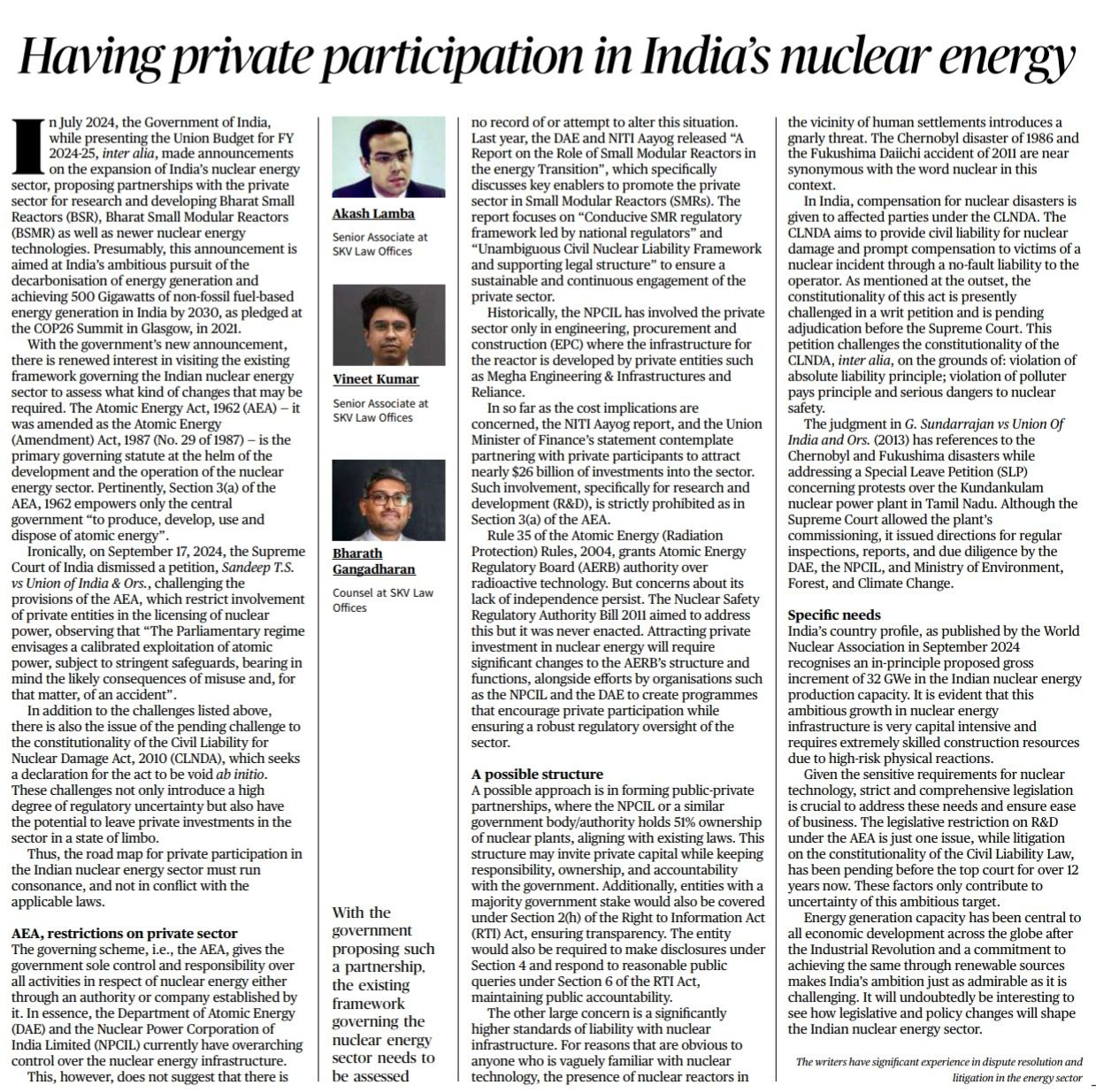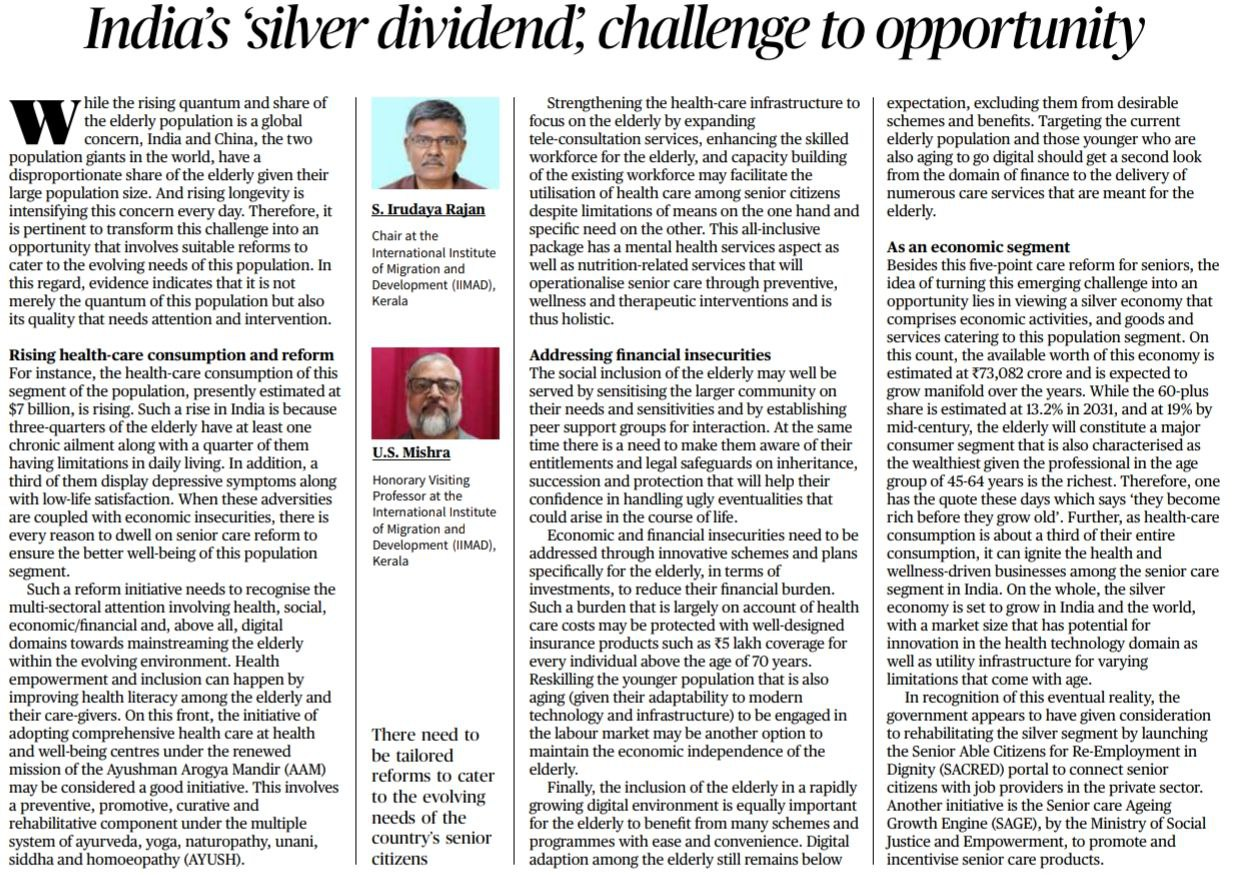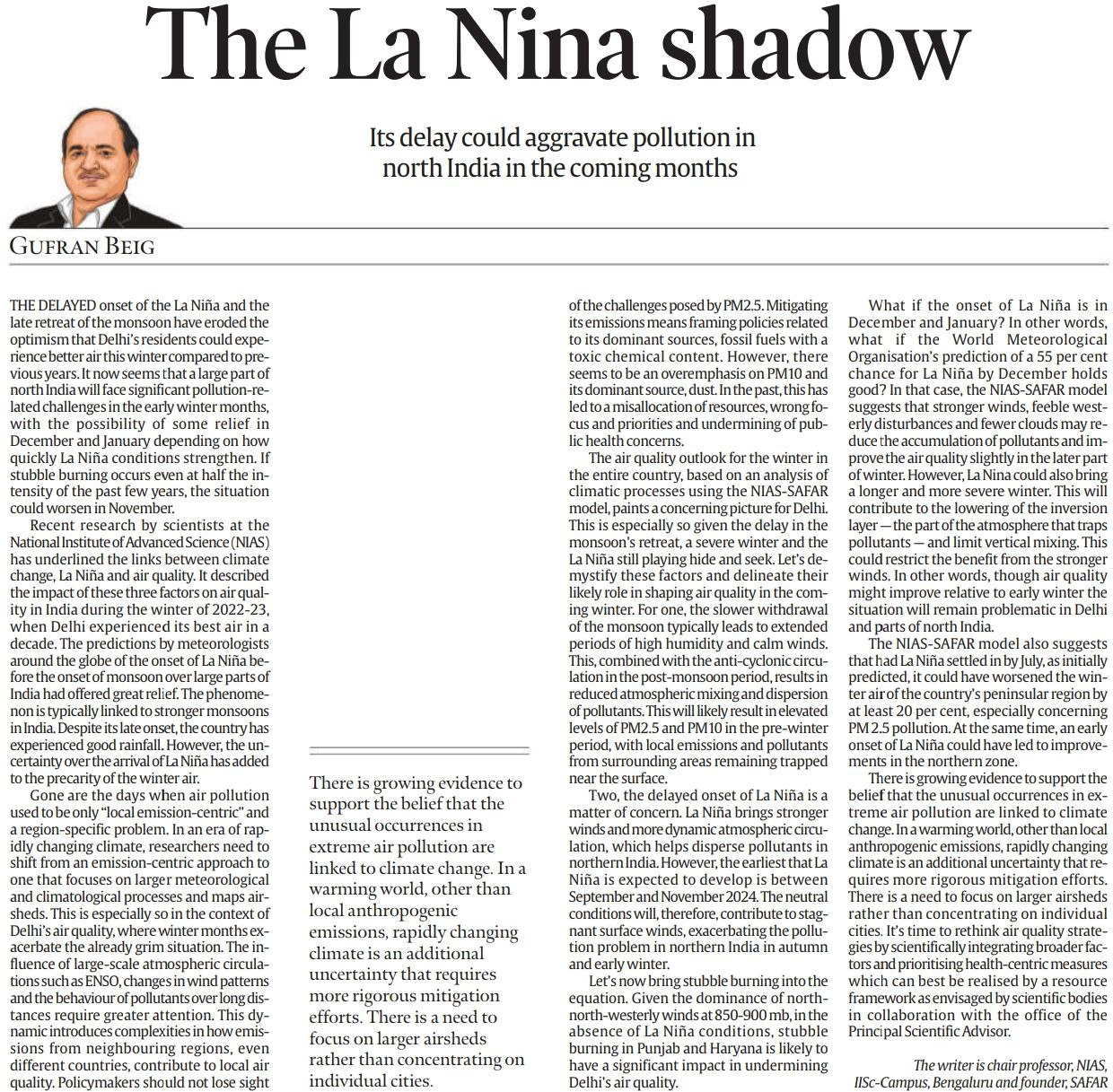1. Private Sector Participation in India's Nuclear Energy: Challenges, Opportunities, and Regulatory Framework
Introduction:
- In July 2024, the Government of India announced a significant move to involve the private sector in nuclear energy expansion, especially in developing Bharat Small Modular Reactors (BSMRs) and other nuclear energy technologies. This aligns with India’s energy transition goals, decarbonization efforts, and the target of achieving 500 gigawatts of non-fossil fuel-based energy generation by 2030, as pledged at COP26 in Glasgow.
- Legal and Regulatory Framework:
- Atomic Energy Act, 1962 (AEA):
- This law governs India’s nuclear energy development and operation. It allows only the government to “produce, develop, use, and dispose of atomic energy.”
- The Atomic Energy (Amendment) Act, 1987 added clarity to the private sector’s role in research and development.
- Atomic Energy Act, 1962 (AEA):
- Recent Supreme Court Ruling:
- On September 7, 2024, the Supreme Court rejected a challenge that sought to remove restrictions on private sector involvement in nuclear energy generation. The case, Sandeep T.S. v Union of India & Ors, was based on the argument that atomic power was being excessively regulated.
- Private Sector Role:
- Despite this ruling, private companies can now participate in certain non-core aspects, such as engineering, procurement, and construction (EPC). Companies like Megha Engineering & Infrastructures and Reliance have already engaged in this space.
- Restrictions on private sector
- The NITI Aayog and Nuclear Power Corporation of India Ltd. (NPCIL) have long debated private sector participation in nuclear energy.
- In 2022, the Department of Atomic Energy (DAE) and National Institute for Transforming India (NITI Aayog) released reports recommending private sector involvement through Small Modular Reactors (SMRs).
- Global Trends:
- Internationally, private sector involvement in nuclear energy is not uncommon, especially in countries that rely on private investments for energy infrastructure.
- The Nuclear Safety Regulatory Authority Bill, 2011 sought to enhance oversight and independent regulation but is still pending.
- Challenges and Concerns:
- Nuclear Liability:
- The Civil Liability for Nuclear Damage (CLND) Act currently places most liability on operators, raising questions about the financial risks of private sector involvement.
- Nuclear Liability:
- Safety and Risks:
- Incidents such as Chernobyl (1986) and Fukushima (2011) underscore the importance of stringent safety regulations, which critics argue might not be enforceable with expanded private sector involvement.
- Environmental and Legal Concerns:
- The Sundararajan vs Union of India (2013) case emphasized environmental and safety risks, particularly in the context of large-scale nuclear disasters.
- Potential Benefits:
- Technological Advancements:
- Private sector participation could boost R&D in newer, safer nuclear technologies like SMRs.
- Financial Investments:
- The Union Ministry of Finance has proposed an ambitious plan to attract nearly $26 billion of private investments into nuclear energy over the next decade.
- Technological Advancements:
Conclusion:
While private participation in India’s nuclear sector marks a significant shift, it must be approached cautiously, with rigorous safety, regulatory, and liability frameworks in place.
Lessons from global nuclear disasters and India’s legal landscape emphasize the need for balanced development in this sector to meet the growing energy demand while safeguarding public safety and environmental concerns.
UPSC Mains Practice Questions:
|
Q. Discuss the implications of private sector participation in India’s nuclear energy sector. How can India balance energy needs with safety concerns? (250 words)
|
2. India's growing elderly population and present challenges
Introduction:
- The elderly population in India is growing rapidly, a trend seen globally, particularly in populous countries like India and China.
- Rising longevity is intensifying this demographic shift, transforming it into both a challenge and an opportunity. There is a pressing need for tailored reforms that cater to the evolving needs of this segment, with attention to both quantity and quality of life.
- Rising Healthcare Consumption and Need for Reform:
- The healthcare needs of the elderly are increasing significantly, with consumption currently estimated at $7 billion.
- Health Challenges:
- Three-quarters of elderly individuals have at least one chronic condition.
- A quarter of the elderly population faces difficulties with daily living due to physical limitations.
- Mental health concerns, such as depression, affect a third of the elderly.
- Healthcare Infrastructure:
- Expanding tele-consultation services, enhancing the workforce, and focusing on preventive, curative, and rehabilitative healthcare (including Ayurveda, Yoga, Naturopathy, Unani, Siddha, and Homoeopathy – AYUSH) is vital.
- The initiative under Ayushman Bharat Arogya Mission (AAM) offers a comprehensive healthcare approach for the elderly, emphasizing holistic care.
- Addressing Financial Insecurities:
- Social Inclusion:
- Raising awareness among the elderly about entitlements, legal safeguards, inheritance, and financial planning is critical to improving their financial security.
- Social Inclusion:
- Pension and Insurance:
- Providing affordable health insurance (e.g., a ₹5 lakh insurance cover for every individual over 70) and tailored pension schemes could reduce financial burdens.
- Economic Participation:
- Reskilling older individuals and enabling their re-entry into the labor market can provide an opportunity to increase their economic independence
- Elderly as an Economic Segment:
- The elderly represent a significant economic segment, with a potential market size estimated at ₹73,082 crore. By 2031, individuals aged 60-plus will constitute 13.2% of the population, growing to 19% by mid-century.
- Consumer Power:
- The elderly are increasingly becoming a key consumer group, with health and wellness-driven businesses catering to their needs. Targeting this demographic for digital services, financial products, and wellness initiatives can harness their economic potential.
- Government Initiatives:
- The government has launched several schemes to support elderly inclusion:
- Senior Able Citizens for Re-Employment in Dignity (SACRED) platform to connect senior citizens with employment opportunities.
- Senior Care Ageing Growth Engine (SAGE) initiative, under the Ministry of Social Justice and Empowerment, promotes innovation in senior care services and products.
- The government has launched several schemes to support elderly inclusion:
Conclusion:
India’s growing elderly population presents challenges in healthcare, financial security, and social inclusion.
However, with the right policies, the “silver dividend” can be harnessed as an opportunity for economic growth and social empowerment.
Focused reforms in healthcare, financial planning, and social inclusion, along with government initiatives, can help India transform this demographic trend into an asset.
UPSC Mains Practice Questions:
|
India’s elderly population is rising rapidly. What are the challenges and opportunities associated with this trend, and how can they be addressed through policy reforms? (250 words)
|
3. The Impact of La Niña's Delay on Air Quality in North India: Challenges and Policy Responses
Introduction:
- The delayed onset of La Niña, coupled with the late retreat of the monsoon, has raised concerns about worsening air quality in North India, particularly in Delhi. While hopes for improved conditions existed, recent climatic factors suggest that air pollution may be aggravated in the coming months.
- La Niña and Air Quality:
- La Niña Phenomenon:
- La Niña is associated with stronger monsoons, and its timely onset typically brings relief through heavier rainfall, reducing pollutants in the air. However, the delayed onset this year could extend pollution-related challenges.
- Link to Pollution:
- The National Institute of Advanced Science (NIAS) has emphasized that La Niña is linked to air quality changes in India. Its delay, combined with a stronger anti-cyclonic circulation, can trap pollutants, exacerbating the situation.
- La Niña Phenomenon:
- Pollution in Northern India:
- Stubble Burning:
- If stubble burning occurs early, as seen in previous years, the concentration of pollutants like 5 may increase significantly. The situation could worsen if La Niña strengthens only by late December or January.
- Delayed Monsoon Withdrawal:
- A late monsoon retreat often leads to longer periods of clear, stable weather, which can trap pollutants close to the ground, preventing their dispersion.
- Overemphasis on PM10:
- In the past, there has been too much focus on larger particulates like PM10, leading to policy misdirection. Experts argue for a more targeted approach, especially with regards to PM2.5, which has more significant health impacts.
- Stubble Burning:
- Challenges Ahead:
- Meteorological Predictions:
- The World Meteorological Organization (WMO) suggests a 55% chance that La Niña will fully develop by December, but uncertainty remains.
- Severe Winter Conditions:
- The expected severe winter, combined with a weak monsoon, could result in more pronounced air quality issues, with particulate matter concentrations rising significantly.
- Wind Patterns:
- Weak winds and temperature inversions can trap pollutants, further worsening the air quality in urban areas like Delhi and parts of Haryana and Punjab.
- Meteorological Predictions:
- Long-term Impact:
- Policy Measures:
- Climate change and variability such as La Niña are becoming increasingly important to consider when framing air quality policies. More attention should be paid to adapting mitigation strategies in light of changing weather patterns.
- Need for Scientific Focus:
- The article underscores the need for real-time research and models like the NIAS-SAFAR system, which integrate meteorological data with pollution indices to provide more accurate forecasts and guide public health interventions.
- Policy Measures:
Conclusion:
The delayed onset of La Niña poses significant risks for air quality in northern India, particularly in major cities like Delhi.
Strategic, science-driven policies are necessary to mitigate pollution-related issues, especially with stubble burning and seasonal climatic changes playing crucial roles in worsening the situation.
Continued research and adaptive policy responses are essential to address the evolving challenges posed by climate variability.
UPSC Mains Practice Questions:
|
|




